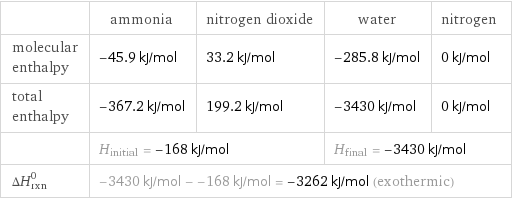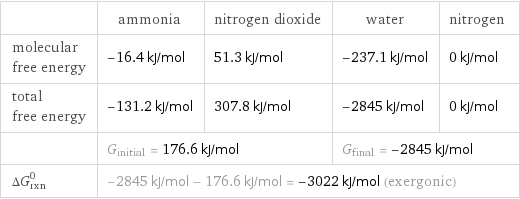Input interpretation

NH_3 ammonia + NO_2 nitrogen dioxide ⟶ H_2O water + N_2 nitrogen
Balanced equation

Balance the chemical equation algebraically: NH_3 + NO_2 ⟶ H_2O + N_2 Add stoichiometric coefficients, c_i, to the reactants and products: c_1 NH_3 + c_2 NO_2 ⟶ c_3 H_2O + c_4 N_2 Set the number of atoms in the reactants equal to the number of atoms in the products for H, N and O: H: | 3 c_1 = 2 c_3 N: | c_1 + c_2 = 2 c_4 O: | 2 c_2 = c_3 Since the coefficients are relative quantities and underdetermined, choose a coefficient to set arbitrarily. To keep the coefficients small, the arbitrary value is ordinarily one. For instance, set c_2 = 1 and solve the system of equations for the remaining coefficients: c_1 = 4/3 c_2 = 1 c_3 = 2 c_4 = 7/6 Multiply by the least common denominator, 6, to eliminate fractional coefficients: c_1 = 8 c_2 = 6 c_3 = 12 c_4 = 7 Substitute the coefficients into the chemical reaction to obtain the balanced equation: Answer: | | 8 NH_3 + 6 NO_2 ⟶ 12 H_2O + 7 N_2
Structures

+ ⟶ +
Names

ammonia + nitrogen dioxide ⟶ water + nitrogen
Reaction thermodynamics
Enthalpy

| ammonia | nitrogen dioxide | water | nitrogen molecular enthalpy | -45.9 kJ/mol | 33.2 kJ/mol | -285.8 kJ/mol | 0 kJ/mol total enthalpy | -367.2 kJ/mol | 199.2 kJ/mol | -3430 kJ/mol | 0 kJ/mol | H_initial = -168 kJ/mol | | H_final = -3430 kJ/mol | ΔH_rxn^0 | -3430 kJ/mol - -168 kJ/mol = -3262 kJ/mol (exothermic) | | |
Gibbs free energy

| ammonia | nitrogen dioxide | water | nitrogen molecular free energy | -16.4 kJ/mol | 51.3 kJ/mol | -237.1 kJ/mol | 0 kJ/mol total free energy | -131.2 kJ/mol | 307.8 kJ/mol | -2845 kJ/mol | 0 kJ/mol | G_initial = 176.6 kJ/mol | | G_final = -2845 kJ/mol | ΔG_rxn^0 | -2845 kJ/mol - 176.6 kJ/mol = -3022 kJ/mol (exergonic) | | |
Entropy

| ammonia | nitrogen dioxide | water | nitrogen molecular entropy | 193 J/(mol K) | 240 J/(mol K) | 69.91 J/(mol K) | 192 J/(mol K) total entropy | 1544 J/(mol K) | 1440 J/(mol K) | 838.9 J/(mol K) | 1344 J/(mol K) | S_initial = 2984 J/(mol K) | | S_final = 2183 J/(mol K) | ΔS_rxn^0 | 2183 J/(mol K) - 2984 J/(mol K) = -801.1 J/(mol K) (exoentropic) | | |
Equilibrium constant
![Construct the equilibrium constant, K, expression for: NH_3 + NO_2 ⟶ H_2O + N_2 Plan: • Balance the chemical equation. • Determine the stoichiometric numbers. • Assemble the activity expression for each chemical species. • Use the activity expressions to build the equilibrium constant expression. Write the balanced chemical equation: 8 NH_3 + 6 NO_2 ⟶ 12 H_2O + 7 N_2 Assign stoichiometric numbers, ν_i, using the stoichiometric coefficients, c_i, from the balanced chemical equation in the following manner: ν_i = -c_i for reactants and ν_i = c_i for products: chemical species | c_i | ν_i NH_3 | 8 | -8 NO_2 | 6 | -6 H_2O | 12 | 12 N_2 | 7 | 7 Assemble the activity expressions accounting for the state of matter and ν_i: chemical species | c_i | ν_i | activity expression NH_3 | 8 | -8 | ([NH3])^(-8) NO_2 | 6 | -6 | ([NO2])^(-6) H_2O | 12 | 12 | ([H2O])^12 N_2 | 7 | 7 | ([N2])^7 The equilibrium constant symbol in the concentration basis is: K_c Mulitply the activity expressions to arrive at the K_c expression: Answer: | | K_c = ([NH3])^(-8) ([NO2])^(-6) ([H2O])^12 ([N2])^7 = (([H2O])^12 ([N2])^7)/(([NH3])^8 ([NO2])^6)](../image_source/bbb2c51d3d5b964db41cd5d62029dcde.png)
Construct the equilibrium constant, K, expression for: NH_3 + NO_2 ⟶ H_2O + N_2 Plan: • Balance the chemical equation. • Determine the stoichiometric numbers. • Assemble the activity expression for each chemical species. • Use the activity expressions to build the equilibrium constant expression. Write the balanced chemical equation: 8 NH_3 + 6 NO_2 ⟶ 12 H_2O + 7 N_2 Assign stoichiometric numbers, ν_i, using the stoichiometric coefficients, c_i, from the balanced chemical equation in the following manner: ν_i = -c_i for reactants and ν_i = c_i for products: chemical species | c_i | ν_i NH_3 | 8 | -8 NO_2 | 6 | -6 H_2O | 12 | 12 N_2 | 7 | 7 Assemble the activity expressions accounting for the state of matter and ν_i: chemical species | c_i | ν_i | activity expression NH_3 | 8 | -8 | ([NH3])^(-8) NO_2 | 6 | -6 | ([NO2])^(-6) H_2O | 12 | 12 | ([H2O])^12 N_2 | 7 | 7 | ([N2])^7 The equilibrium constant symbol in the concentration basis is: K_c Mulitply the activity expressions to arrive at the K_c expression: Answer: | | K_c = ([NH3])^(-8) ([NO2])^(-6) ([H2O])^12 ([N2])^7 = (([H2O])^12 ([N2])^7)/(([NH3])^8 ([NO2])^6)
Rate of reaction
![Construct the rate of reaction expression for: NH_3 + NO_2 ⟶ H_2O + N_2 Plan: • Balance the chemical equation. • Determine the stoichiometric numbers. • Assemble the rate term for each chemical species. • Write the rate of reaction expression. Write the balanced chemical equation: 8 NH_3 + 6 NO_2 ⟶ 12 H_2O + 7 N_2 Assign stoichiometric numbers, ν_i, using the stoichiometric coefficients, c_i, from the balanced chemical equation in the following manner: ν_i = -c_i for reactants and ν_i = c_i for products: chemical species | c_i | ν_i NH_3 | 8 | -8 NO_2 | 6 | -6 H_2O | 12 | 12 N_2 | 7 | 7 The rate term for each chemical species, B_i, is 1/ν_i(Δ[B_i])/(Δt) where [B_i] is the amount concentration and t is time: chemical species | c_i | ν_i | rate term NH_3 | 8 | -8 | -1/8 (Δ[NH3])/(Δt) NO_2 | 6 | -6 | -1/6 (Δ[NO2])/(Δt) H_2O | 12 | 12 | 1/12 (Δ[H2O])/(Δt) N_2 | 7 | 7 | 1/7 (Δ[N2])/(Δt) (for infinitesimal rate of change, replace Δ with d) Set the rate terms equal to each other to arrive at the rate expression: Answer: | | rate = -1/8 (Δ[NH3])/(Δt) = -1/6 (Δ[NO2])/(Δt) = 1/12 (Δ[H2O])/(Δt) = 1/7 (Δ[N2])/(Δt) (assuming constant volume and no accumulation of intermediates or side products)](../image_source/129a297327a15af52ab0c6e079764903.png)
Construct the rate of reaction expression for: NH_3 + NO_2 ⟶ H_2O + N_2 Plan: • Balance the chemical equation. • Determine the stoichiometric numbers. • Assemble the rate term for each chemical species. • Write the rate of reaction expression. Write the balanced chemical equation: 8 NH_3 + 6 NO_2 ⟶ 12 H_2O + 7 N_2 Assign stoichiometric numbers, ν_i, using the stoichiometric coefficients, c_i, from the balanced chemical equation in the following manner: ν_i = -c_i for reactants and ν_i = c_i for products: chemical species | c_i | ν_i NH_3 | 8 | -8 NO_2 | 6 | -6 H_2O | 12 | 12 N_2 | 7 | 7 The rate term for each chemical species, B_i, is 1/ν_i(Δ[B_i])/(Δt) where [B_i] is the amount concentration and t is time: chemical species | c_i | ν_i | rate term NH_3 | 8 | -8 | -1/8 (Δ[NH3])/(Δt) NO_2 | 6 | -6 | -1/6 (Δ[NO2])/(Δt) H_2O | 12 | 12 | 1/12 (Δ[H2O])/(Δt) N_2 | 7 | 7 | 1/7 (Δ[N2])/(Δt) (for infinitesimal rate of change, replace Δ with d) Set the rate terms equal to each other to arrive at the rate expression: Answer: | | rate = -1/8 (Δ[NH3])/(Δt) = -1/6 (Δ[NO2])/(Δt) = 1/12 (Δ[H2O])/(Δt) = 1/7 (Δ[N2])/(Δt) (assuming constant volume and no accumulation of intermediates or side products)
Chemical names and formulas

| ammonia | nitrogen dioxide | water | nitrogen formula | NH_3 | NO_2 | H_2O | N_2 Hill formula | H_3N | NO_2 | H_2O | N_2 name | ammonia | nitrogen dioxide | water | nitrogen IUPAC name | ammonia | Nitrogen dioxide | water | molecular nitrogen
Substance properties

| ammonia | nitrogen dioxide | water | nitrogen molar mass | 17.031 g/mol | 46.005 g/mol | 18.015 g/mol | 28.014 g/mol phase | gas (at STP) | gas (at STP) | liquid (at STP) | gas (at STP) melting point | -77.73 °C | -11 °C | 0 °C | -210 °C boiling point | -33.33 °C | 21 °C | 99.9839 °C | -195.79 °C density | 6.96×10^-4 g/cm^3 (at 25 °C) | 0.00188 g/cm^3 (at 25 °C) | 1 g/cm^3 | 0.001251 g/cm^3 (at 0 °C) solubility in water | | reacts | | insoluble surface tension | 0.0234 N/m | | 0.0728 N/m | 0.0066 N/m dynamic viscosity | 1.009×10^-5 Pa s (at 25 °C) | 4.02×10^-4 Pa s (at 25 °C) | 8.9×10^-4 Pa s (at 25 °C) | 1.78×10^-5 Pa s (at 25 °C) odor | | | odorless | odorless
Units
